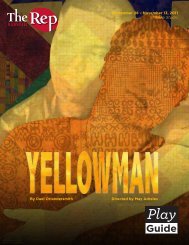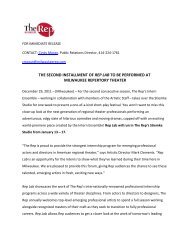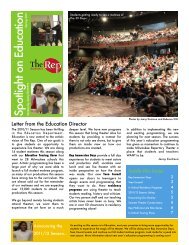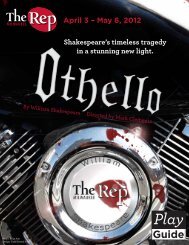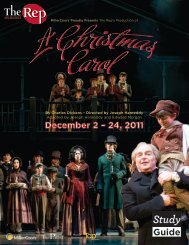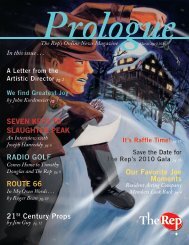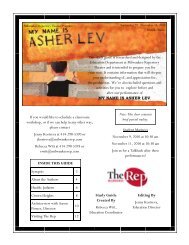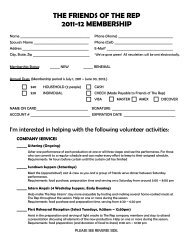Almost, Maine - Milwaukee Repertory Theater
Almost, Maine - Milwaukee Repertory Theater
Almost, Maine - Milwaukee Repertory Theater
Create successful ePaper yourself
Turn your PDF publications into a flip-book with our unique Google optimized e-Paper software.
Written by John Cariani January 1 - February 14, 2010 Stiemke <strong>Theater</strong>A STUDY GUIDE FOR STUDENTS AND EDUCATORSThis study guide is researched and designed by the EducationDepartment at the <strong>Milwaukee</strong> <strong>Repertory</strong> <strong>Theater</strong> and is intended toprepare you for your visit. It contains information that will deepen yourunderstanding of, and appreciation for, the production. We’ve alsoincluded questions and activities for you to explore before and after ourperformance of ALMOST, MAINE.
Study GuideCreated ByRebecca Witt,Education CoordinatorWith ContributionsFromPeter Mol,Education InternZoe Cohen,Literary InternEditing ByJenny Kostreva,Education DirectorZoe Cohen,Literary InternPeter Mol,Education InternIf you would like to schedule a classroomworkshop, or if we can help in any otherway, please contactINSIDE THIS GUIDESynopsis 2About the Author 2<strong>Maine</strong> Facts 3Why Vignettes? 4The NorthernLights6Visiting The Rep 8Jenny Kostreva at 414-290-5370jkostreva@milwaukeerep.comRebecca Witt at 414-290-5393rwitt@milwaukeerep.com
About the AuthorSynopsisOn a cold, snowy night theresidents of <strong>Almost</strong>, <strong>Maine</strong> dealwith the toughest thing there isin life: love. Happy and unhappyromances are as abundant as thestars that twinkle above the“It says that peoplefrom <strong>Maine</strong> are different,that theylive life „the waylife should be…‟”citizens of this small town. Through seven short vignettes,we are able to see these people become excited by the ideaof love and what it means to be or not.With your class have a discussion about love. What goodcan come from it? What are some bad things that cancome from it? What do you think it’s like to be in love? Doyou think there is somebody out there for everyone?
play ALMOST, MAINE. It premiered at the Portland StageCompany, received instant acclaim and was named one ofthe best plays of the year by The Wall Street Journal. Theplay is also featured in New Playwrights: Best Plays of 2006.ALMOST, MAINE has been produced at 300 theaters inthe United States and has also been producedinternationally. In 2006, Cariani wrote his second play,CUL-DE-SAC which was premiered Off-Broadway.<strong>Maine</strong> FactsHere are some interesting facts that you mayor may not have known about <strong>Maine</strong>:<strong>Maine</strong> is the eastern-most and northeastermoststate in the United States.<strong>Maine</strong> is about the same size as the rest of theNew England states (Vermont, New
Hampshire, Massachusetts, Connecticut andRhode Island) combined, with a total area ofabout 35,400 square miles.<strong>Maine</strong> is the only state in the country that’s attached toonly one other state.With 1.3 million residents <strong>Maine</strong> is the most sparselypopulated state east of the Mississippi River. It has 40people per square mile.<strong>Maine</strong> has more moose per square mile that any otherstate.90% of the nation’s toothpick supply is produced in<strong>Maine</strong>.Why do you think the Cariani made up a town for the play?Why not set it in a real city? Do you think that there is anysignificance in the name <strong>Almost</strong>? Discuss these questionswith your class.
is hinted at by the Northern Lights, which serve astransitions between scenes. Obviously it is not possible toactually tell each story at literally the exact same momenton stage, you can imagine what a mess that would be!Breaking the play into nine vignettes allows each story tobe told effectively, while maintaining the feeling ofsimultaneous timing.Another way to look at the format of the play has more todo with the content of the stories themselves. Think ofeach scene as a puzzle piece, each printed with an imagethat is unrecognizable. It is not until you arrange all of thepieces just so, fitting them together in the correct orderthat the bigger picture becomes visible. This is not unlikethe painting Dave has created for Rhonda in scene eight,“Seeing the Thing.” Describing his painting, he explains:And this is my version of one of those stare-at-it-until-you-see-the-thing-things. Ever seen one of those? Some of theold painters did it with dots…but I did it with a buncha
little blocks of colors, see, and if you look at the blocks ofcolors, it’s just colors, but if you step back and look at thewhole thing, it’s not just little blocks of colors, it’s apicture of something. (59)This becomes a metaphor for the play as a whole. This isnot to say that each individual scene is lacking somehow,that it is “just a block of color” per se, for surely each is, asCariani puts it, “its own unique emotional nut tocrack” (68). It is undeniable however that when viewedtogether, the stories take on a new emotional complexity.While each scene tells its own story with a beginning,climax, and end, when viewed together we can see thebigger picture, a grander story - one concerned with thevery nature of humans, love, and magic. ALMOST,MAINE tells nine stories, but it also tells one story.The format of this play not only allows the playwright to
suggest a synchronicity of time, but of message. It alsomakes for a really fun, diverse theater-going experience!The Vignettes“Her Heart” featuring East and Glory“Sad and Glad” featuring Jimmy, Sandrine and a Waitress“This Hurts” featuring Marvalyn and Steve“Getting it Back” featuring Gayle and Lendall“They Fell” featuring Randy and Chad“Where it Went” featuring Phil and Marci“Story of Hope” featuring Hope and a Man“Seeing the Thing” featuring Rhonda and DaveJust from looking at the names of the vignettes and charactersinvolved, what do you think each scene will beabout? Discuss and record your answers with a smallgroup. After you see the show, go back to your guessesand see how accurate you were.
The Northern Lightsby Peter MolThe northern lights, orAurora Borealis, is one ofthe most beautifulnatural occurrences thatcan be seen on Earth.Since the beginning oftime it has taken place inthe sky above.Aurora Borealis isactually a collection ofcharged particles in the magnetosphere (a volume of spacethat surrounds the Earth). Earth has a magnetospherebecause of it’s internal magnetic field. Since the sun is so
hot (almost 10,000 degrees Fahrenheit on the surface), it isconstantly burning off pieces of its outermost layer. Thosepieces contain electrons and protons (also known asplasma) which then escapes into outer space. Solar windscollide with Earth’s magnetosphere and the electrons andprotons are unable to penetrate it so they move along sideof the magnetosphere and try to bend it. This is whatcauses the colors we see in the sky.There are only three different colors that can be seen: blue,green and red. Different gases give off different colors andthe Aurora Borealis is primarily made up of oxygen, red,and nitrogen, green and blue. Depending on how fast themolecules are moving and the altitude of the molecules,the three basic colors can vary in shade.Although the Auroras may be seen anywhere on Earth,they are mainly seen in the northern latitudes. To see it,the sky needs to be fairly dark and clear of clouds. The
est time to see it is around midnight, or a few hoursbefore or after. The moon can sometimes be very bright,so this must be taken into account when looking forAurora. There is always at sometime an Aurorahappening on earth; however, it cannot always be seen.There is a lot of folklore behind Aurora Borealis. The FoxIndians of Wisconsin believed that the northern lightswere the spirits of their slain enemies waiting to takerevenge. The Algonquin Indians believed that the lightscame from Nanahbozho the Creator lighting a fire in thenorth to remind his people of his continued love.Divide into groups and do some more research on thefolklore behind the Aurora Borealis. What else did youfind? Share your research with your class and discuss whyyou think these folklores exist.The vignettes are supposed to take place at the same ex-
act time underneath the northern lights. Why do you thinkCariani chose to do this? What is the significance of thenorthern lights? Discuss your ideas with your classmates.Resources and Further ReadingCariani, John. <strong>Almost</strong>, <strong>Maine</strong>. Dramatists Play Service: New York,2007.Facts About <strong>Maine</strong>. 2009. <strong>Maine</strong>.gov. 19 November 2009..Hall, Calvin, Daryl Pederson and George Bryson. Northern Lights:The Science, Myth, and Wonder of Aurora Borealis. Sasquatch Books:Seattle, 2001.Jokinen, Anniina. Aurora Borealis, the Northern Lights, in Mythologyand Folklore. 2007. 25 November 2009..Lummerzheim, Dave. Frequently Asked Questions About Aurora andAnswers. Geographical Institute. 18 December 2009. University ofAlaska Fairbanks. 22 November 2009..The Official John Cariani Website. 2009. 19 November 2009..
VISITING THE REPThe <strong>Milwaukee</strong> <strong>Repertory</strong> <strong>Theater</strong> is housed in the <strong>Milwaukee</strong> Center at the corner ofWells and Water Streets, downtown. Our building was formerly the home of the ElectricRailway and Light Company. This name is still carved on the wall outside.You’ll enter on the Wells Street side into a large, open space. Our box office will bevisible on your left as you come through the front doors. The large space is the mainhub for the businesses that share this building: a bank, an office tower, the Pabst <strong>Theater</strong>,and the Intercontinental Hotel. If you walk into the center of this area, you’ll see astaircase on your left. You will take this staircase to the Powerhouse <strong>Theater</strong> lobby.Inside the lobby are restrooms, water fountains, and a coat check. If you decide tobring a snack, please know that food and drink are NOT permitted in the theater.However, you can leave things (at your own risk) in the coat check room, and enjoythem outside the theater during intermission. Most plays have one intermission that isabout 20 minutes long. You might also want to look for signs in the lobby which givethe full “running time” of the play.For more information on our education programs and our productions,please visit our website at www.milwaukeerep.com“You need three things in the theatre – the play, the actors and the audience, and eachmust give something.” – Kenneth Haigh
<strong>Theater</strong> is described as a collaborative art form. The success of a production reliesupon every member of the process: playwrights, directors, designers, technicians, actorsand the audience. Plays require audiences to give a new life to performancesthrough their careful attention and enthusiastic reactions. The audience has an activerole to play and the actors rely on you to be respectful and attentive. Through yourobservation of sets, costumes, lighting and the work of the actors, you’ll be better ableto follow the story and enjoy its live presentation. You are important in the final performanceand your participation is what makes this process worthwhile.Programs in the EducationDepartment receive generousfunding from:The Helen BaderFoundationThe Einhorn FamilyFoundationGE HealthcareThe Harley DavidsonFoundationThe Richard and EthelHerzfeld FoundationJohnson ControlMPS Partnership for theArts<strong>Milwaukee</strong> Arts BoardNational City BankNorthwestern MutualFoundationThe <strong>Milwaukee</strong> <strong>Repertory</strong> <strong>Theater</strong>Education DepartmentJenny Kostreva, Education Directorjkostreva@milwaukeerep.com414-290-5370Rebecca Witt, Education Coordinatorrwitt@milwaukeerep.com414-290-5393




